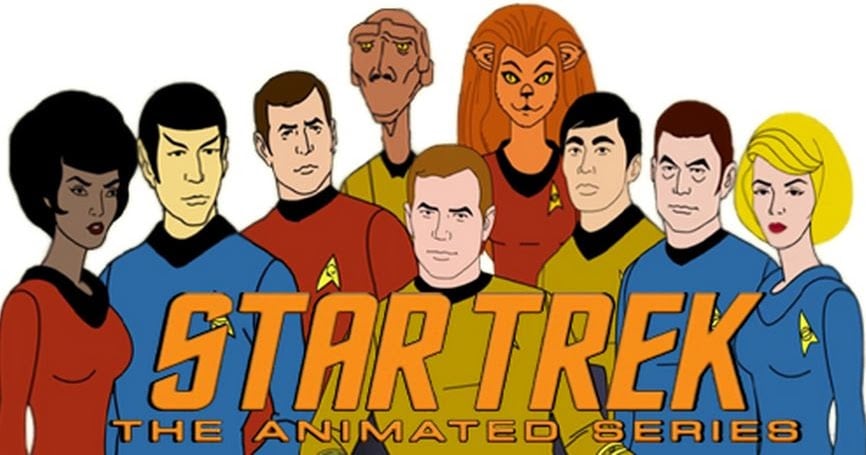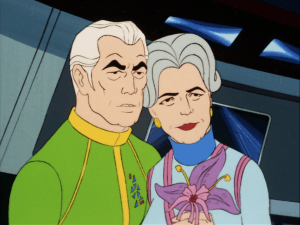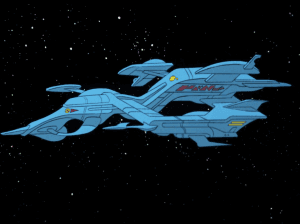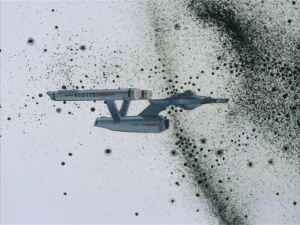
Welcome back to ‘Final Frontier Friday’! We’re heading back to the seventies this week for a look at ‘The Counter-Clock Incident’, the final installment of ‘Star Trek: The Animated Series’.
‘The Counter-Clock Incident’ was written by Fred Bronson using the pen name John Culver. The reason for the pen name? At the time, Bronson was working as the show’s NBC publicist and feared that it might be considered “improper” for an NBC employee to write for one of NBC’s shows. Bronson, incidentally, would maintain his association with ‘Star Trek’ for quite some time, appearing as an extra during the rec deck briefing in ‘Star Trek: The Motion Picture’ and contributing a pair of episodes to ‘Star Trek: The Next Generation’.
Because Bronson was, even by 1974, a long-time ‘Trek’ fan, his episode is littered with references to earlier installments. This includes nods to things like the Beta Niobe supernova (seen in ‘All Our Yesterdays), the Babel planetoid (‘Journey to Babel’), Capella IV (‘Friday’s Child’), and the star Minara (‘The Empath’). But of course, the most noteworthy (and by far the most interesting) of all these references is the introduction of Robert April, the original captain of the Enterprise, preceding both Kirk and Pike.

And that – the appearance of Robert April – is the real hook of the episode, at least for fans like myself (and presumably at least a few of you, dear readers). We’ve touched on this a bit in the past, but April has occupied a unique position in the collective imagination of ‘Trek’ fans, owing perhaps to the fact that the idea of Robert April and of course, to the fact that the character remains to this day a largely blank slate.
April originated, famously, as captain of the SS Yorktown and lead character of ‘Star Trek’ as described in ‘Star Trek is…’, a first draft pitch document for the series that Roddenberry wrote in March 1964. Described (not unlike his “successors”) as a “space-age Captain Horatio Hornblower”, the name Robert April remained in use as late as some of the early script drafts of ‘The Cage’ before being changed to Christopher Pike. And of course, Pike would, in turn, give way to James Kirk during the development of the second pilot. But despite this relative obscurity, the idea of April having been the first captain of the Enterprise rooted itself firmly in fan imagination early on (to the extent that the character would eventually be included in the ‘Star Trek Encyclopedia’, represented by a photo of Gene Roddenberry in a Starfleet uniform)
‘The Counter-Clock Incident’ marks the first reference to the character in a ‘Star Trek’ production and thus, his introduction into ‘Star Trek’ continuity. Sort of. Your mileage may vary, but the official line on the animated ‘Star Trek’ (per word of Roddenberry) was that it wasn’t canon, though elements of it were thanks to references to episodes like ‘Yesteryear’ (or even April himself, who went unmentioned in live action until his inclusion in an Okudagram (do we still call them that?) in ‘Star Trek: Discovery’) that were included in live action episodes.

Canon status aside, ‘The Animated Series’ itself remained relatively obscure for a long time, to the extent that (in contrast to its live-action counterparts) a DVD release was not seen as a given (though it ultimately did happen, and the age of streaming has somewhat raised the show’s profile once again). But despite that, the show made some brilliant and underappreciated contributions to the larger whole of ‘Star Trek’. But is ‘The Counter-Clock Incident’ one of them?
The Enterprise is transporting Commodore Robert April – the first captain of the Enterprise, now a Federation ambassador-at-large – to the Babel planetoid, where the seventy-five-year-old dignitary is due to be honored on the occasion of his retirement from Starfleet. April is accompanied by his wife Sarah, who served as his chief medical officer during his time in the Enterprise. While en route to Babel, they stop to observe the Beta Niobe supernova remnant. As they do so, an unidentified object approaches the Enterprise on a collision course at the impossibly high speed of warp 36. The Enterprise easily evades the ship, quickly realizing that it was trying to hit them. Rather, it is on course for the heart of the nova. It at first ignores their hails, establishing visual contact only after the Enterprise locks on a tractor beam to slow them down. The vessel’s commander speaks unintelligibly, though Uhura’s translator determines that the alien is speaking in reverse, and they replay her message accordingly. She insists that she is on a priority mission and demands to be released from the tractor beam. As the strain of tractoring the alien vessel threatens to burn out the Enterprise’s engines, Kirk gives the order to release the beam. The controls, however, are frozen and the Enterprise is dragged into the nova.
 Emerging from the nova, the Enterprise finds itself in a “reverse universe, where black stars shine in a white void.” The alien ship continues to tow the Enterprise, as the crew scrambled to adjust to controls that now work in reverse. Sarah April, meanwhile, is shocked to find the decaying flower she’d been carrying is suddenly and inexplicably in bloom. Spock adds that the ship’s chronometer is running in reverse, indicating that the flow of time has as well. This, the longer the crew remains in this universe, the younger they will become. The alien captain hails the Enterprise, and the crew finds that they can now understand her perfectly. She identifies herself as Karla Five and explains that she is an explorer who found herself in our universe when a dead star suddenly came to life and pulled her in – the reverse of the Beta Niobe nova. Because They occupy the same location in both universes, these novas created a gateway between the two realities. However, Beta Niobe’s counterpart is no longer a nova – it has become a proper star, and thus the gateway is closed. The crew thus decides to accompany Karla Five to her homeworld of Arret, where it is hoped the local scientists will be able to help them return home. Upon arrival, Kirk, Spock, and April beam down to the surface, where they join Karla Five in a laboratory belonging to her son, Karl Four. With Karl Four’s assistance, they compare maps of their respective galaxies, looking for other corresponding Novas. Though none overlap, they speculate that they could, as Kirk puts it, play midwife to a star in this universe, effectively creating their own path home. They set about doing exactly that, with Karla Five volunteering the use of her ship to tow the Enterprise into the nova (as they were only able to make the trip in the first place because Karla’s vessel towed them at several times their maximum speed.
Emerging from the nova, the Enterprise finds itself in a “reverse universe, where black stars shine in a white void.” The alien ship continues to tow the Enterprise, as the crew scrambled to adjust to controls that now work in reverse. Sarah April, meanwhile, is shocked to find the decaying flower she’d been carrying is suddenly and inexplicably in bloom. Spock adds that the ship’s chronometer is running in reverse, indicating that the flow of time has as well. This, the longer the crew remains in this universe, the younger they will become. The alien captain hails the Enterprise, and the crew finds that they can now understand her perfectly. She identifies herself as Karla Five and explains that she is an explorer who found herself in our universe when a dead star suddenly came to life and pulled her in – the reverse of the Beta Niobe nova. Because They occupy the same location in both universes, these novas created a gateway between the two realities. However, Beta Niobe’s counterpart is no longer a nova – it has become a proper star, and thus the gateway is closed. The crew thus decides to accompany Karla Five to her homeworld of Arret, where it is hoped the local scientists will be able to help them return home. Upon arrival, Kirk, Spock, and April beam down to the surface, where they join Karla Five in a laboratory belonging to her son, Karl Four. With Karl Four’s assistance, they compare maps of their respective galaxies, looking for other corresponding Novas. Though none overlap, they speculate that they could, as Kirk puts it, play midwife to a star in this universe, effectively creating their own path home. They set about doing exactly that, with Karla Five volunteering the use of her ship to tow the Enterprise into the nova (as they were only able to make the trip in the first place because Karla’s vessel towed them at several times their maximum speed.
